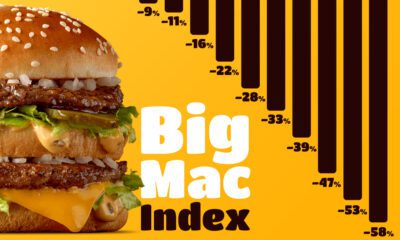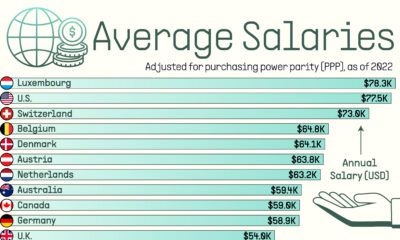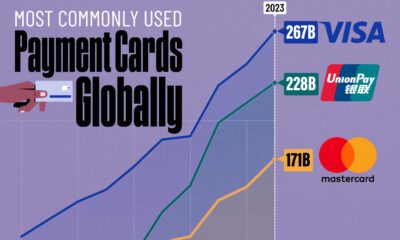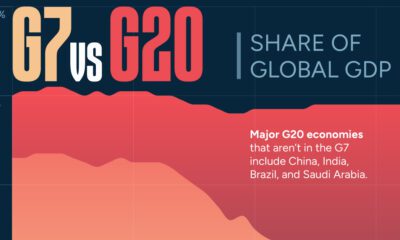Julia Wendling
2024-07-24 14:56:38
www.visualcapitalist.com
Ranked: The Top Performing Major Currencies (2014-2023)
Monetary policy, geopolitical events, and economic conditions—among other factors—significantly influence currency performance in the foreign exchange market.
Which major currencies have performed the best and worst over the last decade, and what are the reasons behind their movements?
To answer this question, we partnered with OANDA to visualize a decade of highs and lows of the top eight most-traded currencies, by volume, according to the Bank for International Settlements.
The U.S. Dollar: The Top Foreign Exchange Performer on Our List
The U.S. dollar (USD) was the best-performing currency of the last decade, taking top spot in six of the last 10 years. Relatively stable economic activity and the role of the USD as the world’s reserve currency contributed to its general strength.
| Year | USD  |
Rank |
|---|---|---|
| 2014 | +12.5% | 1 |
| 2015 | +9.3% | 1 |
| 2016 | +4.1% | 1 |
| 2017 | -9.8% | 8 |
| 2018 | +4.2% | 1 |
| 2019 | +0.3% | 5 |
| 2020 | -7.1% | 8 |
| 2021 | +6.8% | 1 |
| 2022 | +8.0% | 1 |
| 2023 | -2.0% | 6 |
Note: Year-over-year percent changes were calculated using average mid-point data for December 31st. The USD was calculated using OANDA’S data of the following currencies and weights, as per ICE’s U.S. Dollar Index estimates: euro (57.6%), Japanese yen (13.6%), pound sterling (11.9%), Canadian dollar (9.1%), Swedish krona (4.2%), and Swiss franc (3.6%).
Importantly, the USD also represents a safe-haven investment in times of crisis, meaning investors will often put money in the currency during periods of instability, such as during the 2014–2016 oil price shock.
Post-COVID-19, the USD peaked in 2022 in response to aggressive interest rate hikes, though it came off its highs in 2023.
Conversely, a failure to pass healthcare and tax reforms led to the 2017 “Trump Slump.” In 2020, record low interest rates in the U.S. and the nation’s difficulties combatting the COVID-19 virus contributed to its over-7% decline that year.
The Japanese Yen: A Struggle Against Low Interest Rates
The Japanese yen was the lowest performing currency in the group over the last decade, coming in last in four of the 10 years we analyzed.
| Year | JPY  |
Rank |
|---|---|---|
| 2014 | -12.2% | 8 |
| 2015 | -0.7% | 3 |
| 2016 | +2.9% | 3 |
| 2017 | +3.9% | 7 |
| 2018 | +2.4% | 2 |
| 2019 | +1.3% | 4 |
| 2020 | +5.3% | 5 |
| 2021 | -10.4% | 8 |
| 2022 | -12.2% | 8 |
| 2023 | -7.0% | 8 |
Note: Currency performance measured using non-USD/USD forex pair. Year-over-year percent changes were calculated using average mid-point data for December 31st.
The long-standing gap between interest rates in Japan and the U.S. is largely to blame.
Higher interest rates typically attract foreign investment, so Japan’s ultra-low interest rates since the late 1990s have deterred capital inflows, thus lowering demand for the currency. This has put downward pressure on the yen in favor of the USD.
Other Foreign Exchange Movements
The Canadian dollar (CAD), which has historically exhibited a strong correlation to oil prices, also suffered in the 2014 oil price slump. However, the link between CAD and oil has broken down in recent years.
The British pound suffered in the wake of the Brexit vote, falling nearly 17% in 2016 to a 31-year low, as noted by The Guardian. The pound also underperformed in 2022 following the disastrous fiscal policy announcements that prompted the resignation of former Prime Minister Liz Truss.
On the back of economic growth hitting a 10-year high, the euro performed exceptionally well in 2017, gaining almost 14% during the year.
Understanding the Markets
Price movements in the foreign exchange market are complex, but understanding how currencies have performed in the past, and the factors driving those changes, can help investors prepare. Learning how to manage risk, and having a trading plan, are also important.
Note: Past performance is not indicative of future results.

Learn how to trade smarter with OANDA’s free trading guide
var disqus_shortname = “visualcapitalist.disqus.com”;
var disqus_title = “Ranked: The Top Performing Major Currencies (2014-2023)”;
var disqus_url = “https://www.visualcapitalist.com/sp/ranked-the-top-performing-major-currencies-2014-2023/”;
var disqus_identifier = “visualcapitalist.disqus.com-168663”;
-

 Markets1 day ago
Markets1 day agoVisualized: How U.S. Sports Leagues Make Money
We break down the five major U.S. sports leagues by revenue as billions are generated from ticket sales, sponsorships, and media deals.
-

 Markets2 days ago
Markets2 days agoMapped: The Price of a Big Mac Across the World
The price of a Big Mac varies substantially across the globe. The Big Mac Index uses these price variations to assess currency valuations.
-

 Markets1 week ago
Markets1 week agoRanked: Average Annual Salaries by Country
See how average annual salaries vary across 30 different countries, adjusted for purchasing power parity (PPP).
-

 Markets1 week ago
Markets1 week agoCharted: Visa, Mastercard, and UnionPay Transaction Volumes
Card services tend to be imagined as a duopoly between Visa and Mastercard. However, China’s UnionPay has all but caught up.
-

 Markets1 week ago
Markets1 week agoRanked: The Largest Sector ETFs, by AUM
This graphic lists the largest sector ETFs by AUM in 11 major stock sectors, including technology, energy, and healthcare.
-

 Markets1 week ago
Markets1 week agoCharted: The G7’s Declining Share of Global GDP
The G7’s share of global GDP has been shrinking since the early 2000s. See the full story in this infographic.
The post Ranked: The Top Performing Major Currencies (2014-2023) appeared first on Visual Capitalist.




















































![J1772 Charging Adapter for Tesla Model 3 Y S X [Safety Certified] 80 Amp 240V AC Fast…](https://techcratic.com/wp-content/uploads/2024/11/71Mii9k40bL._AC_SL1500_-360x180.jpg)

















